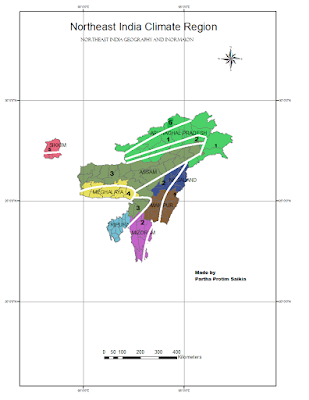The climate of Northeast India in general Tropical Monsoon climate. Due to its location and the tropic of cancer passes across its souther part through Tripura and Mizoram. Therefore, it has essentially a tropical climate.
But its location and topography and presence of mountains and plateaus have rendered its climate somewhat different from that of other parts of India. The Factors influencing the region's climate may be listed as follows.
Factors Influencing The Climate of Northeast India
1. The situation of the hills, plateau, and mountains in the regions.
2. The seasonal change in the pressure condition over The Bay of Bengal on the one hand and over the north-western landmass on the other.
3. The tropical oceanic air-masses that blow over this
region.
4. The occasional visit of the westerly lows in winter.
5. Presence of local mountain and valley winds.
6. Presence of numerous vast water bodies and extensive forests and development of local cyclones.
The climate of the region can be understood clearly with the following description:
- The Himalayas in the North, the Patkai and other hills and mountains in the east and the Meghalaya Plateaus in the middle have affection the general tropical warm climate of the regions.
- Many of these hills and mountains are high enough rendering the cool and bracing.
- The Himalayan mountain chain and the Patkai and high ranges along with Manipur and Mizoram borders with Myanmar prevent the rains bearing monsoon winds from escaping from this region. Further, these ranges do not allow the dry and cold winds of central Asia to enter the Northeast region.
- The Meghalaya Plateau, standing athwart the course of the southwest monsoon winds, make them rise geographically, causing the heaviest rainfall in the world in its southern margin.
- The Himalayan and eastern hills ranges also cause an orographic rise of monsoon wind with consequent heavy rainfall in Northeast India.
- Another very important effect of the encircling hills and mountains on the climate of the region is that in summer while the plains become hot, the air over the hills and mountains remains relatively cool.
- Thus local low-pressure systems are built up over the valleys. these low-pressure systems over the Brahmaputra and Barak valleys obviously modify the climates of this region.

